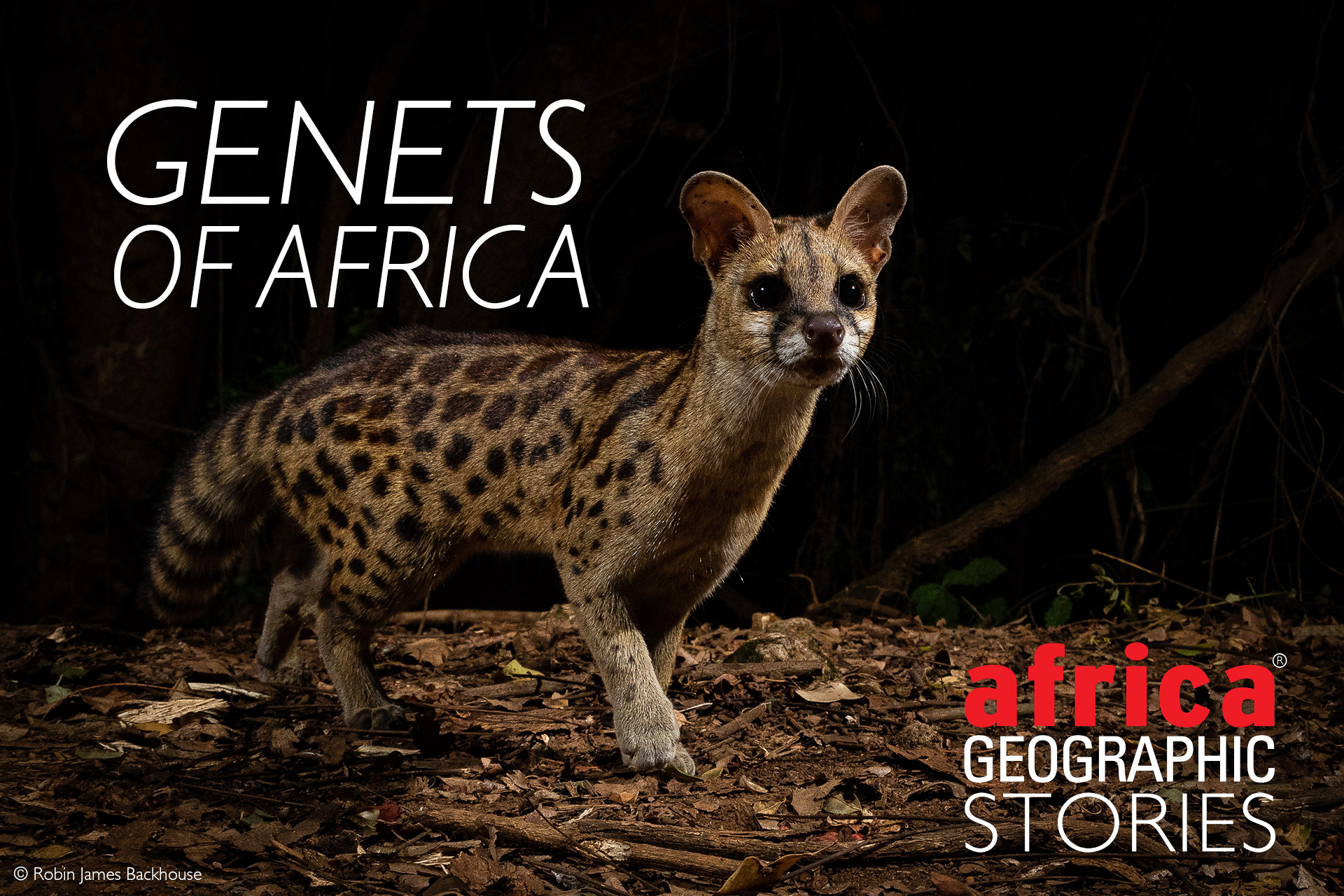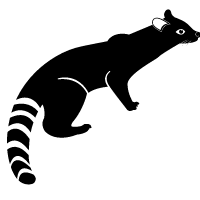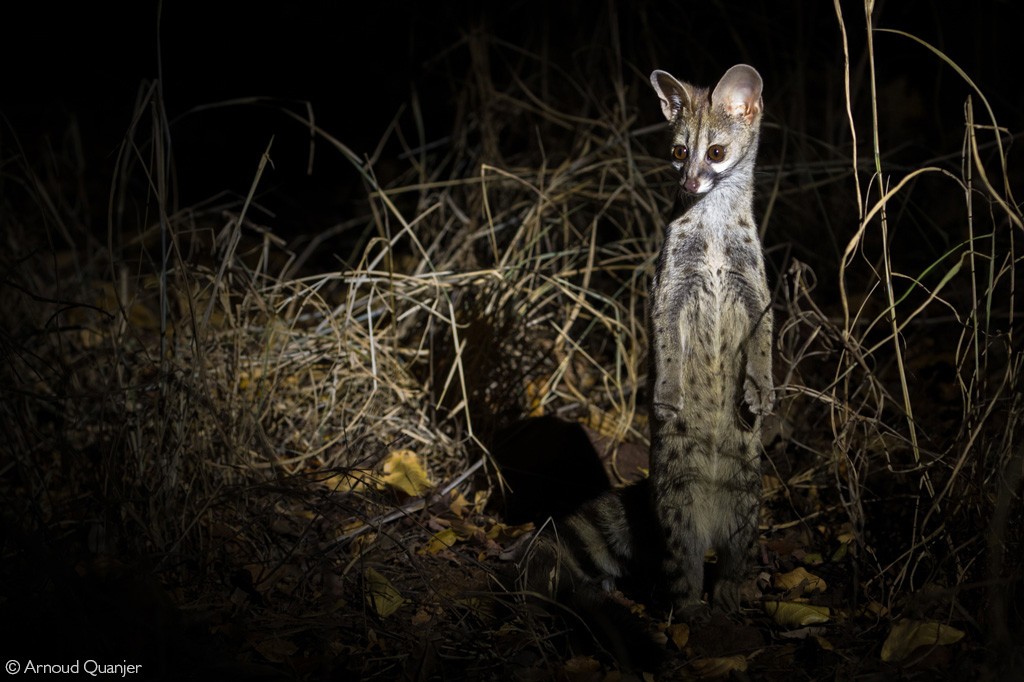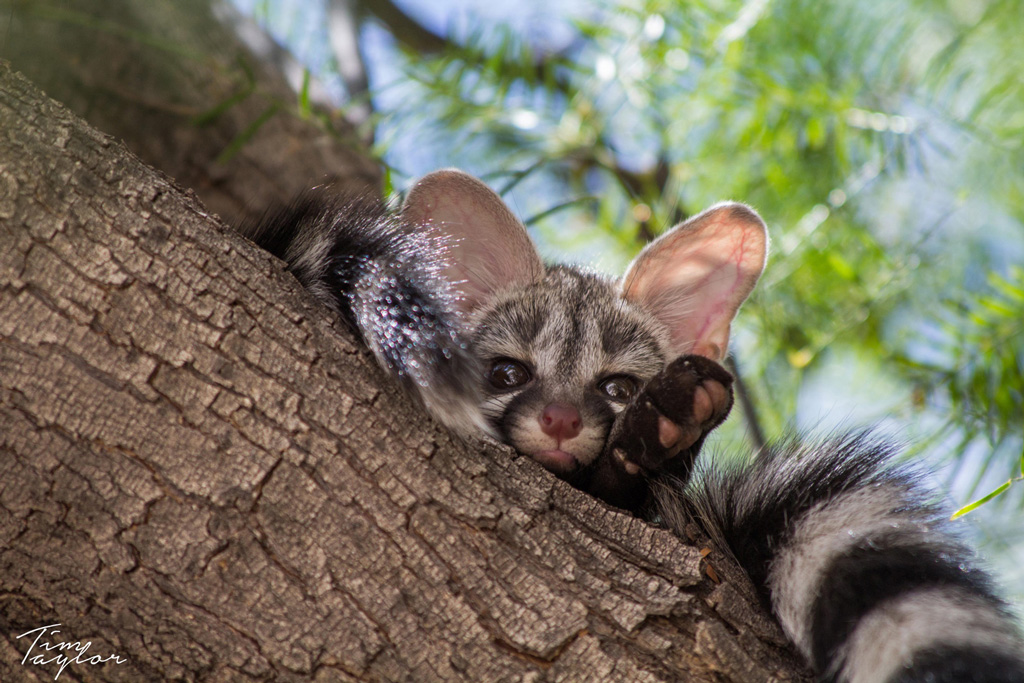
Mongoose cats or catlike mongooses?


For an entirely terrestrial animal, it is astonishing how genets seem to embody the very essence of water. Perhaps this seems a somewhat tortured comparison, but there is no other way to describe how these lithe little predators flow over obstacles, up trees and through the undergrowth. Though frequently encountered on safari (albeit usually just a brief glimpse), few realise how diverse the genet family truly is.

A genet-ic confusion
In fairness, one might be forgiven for failing to keep track of the complexities involved in genet taxonomy – even the scientists are still battling to get it right. Genets belong to the Viverridae family, with civets as their closest relatives. But the viverrids (genets and civets), mustelids (badgers and otters) and herpestids (mongooses) have always presented something of a taxonomic imbroglio for experts. For now, suffice to say that the IUCN Red List currently recognises 14 species of genet that slink, bound, and prowl across the continent. However, this list is likely to increase, and genetic and behavioural research has already identified at least three genets due to graduate from subspecies to a fully-fledged species classification.
Before the DNA technologies that have made such phylogenetic calls infinitely easier, the historic confusion surrounding the viverrids could be attributed to their mixed-bag morphology. Genets look for all the world as though a cat and a mongoose became entangled in an amorous muddle a few thousand years ago. Their bodies are indisputably feline, albeit with shorter legs and longer tails, but their facial features are sharp and mongoose-like. This only shows how decidedly deceptive looks can be because, while genets are indeed family cousins of the mongooses, they are more closely related to hyenas than cats.
Whatever their species and subspecies status, most genets are all but identical at a cursory glance. They all have a black dorsal stripe, spotted coats, banded tails and high-set oval ears. With needle-sharp teeth and a pounce to rival any African felid, these nocturnal little predators spend their nights terrorising tiny mammals, birds, and reptiles on the ground and in the trees (or begging chop bones from delinquent lodge guests).


Spot the difference
Of the 14 recognised species, the rufous-coloured servaline genet (Genetta servalina), the not-actually-all-that-big giant forest genet (G. victoriae) and the mysterious but presumably piscivorous aquatic genet (G. piscivora) all inhabit the Central African rainforests of the Congo region. The delicate Hausa genet (G. thierryi), the obscure Bourlon’s genet (G. bourloni), the vulnerable crested genet (G. cristata), pardine genet (G. pardine), the Johnston’s genet (G. johnstoni) and the long-missing (but probably not extinct) king genet (G. poensis) all occupy West Africa. The Ethiopian genet (G. abyssinica) lives up to its name by inhabiting Ethiopia (and Eritrea, Somalia, Djibouti, and Sudan), and the miombo genet (G. angolensis) wanders the woodlands of Angola, Zambia and southern Tanzania. The Cape genet (G. tigrina) is restricted to the southern and eastern regions of South Africa.
The common genet (G. genetta) theoretically has the widest distribution of all species, extending across most of Africa and is the only species to occur outside of the continent, in southwestern Europe and the Middle East. It is closely followed by the large-spotted genet (G. maculata – also called the rusty-spotted genet), also found throughout most of sub-Saharan Africa.
The observant among you will have noticed the glaring omission of the small-spotted genet from the list. That is because, for now, the small-spotted genet is still officially considered a subspecies of the common genet. This could potentially come as a rather devastating realisation for southern African guides who have spent their careers double- and triple-checking which of the two species usually has the black tail tip (it’s the large-spotted, by the way) when hurriedly trying to distinguish between the two by the light of a spotlight. The good news is that the South African small-spotted genet (soon to be G. felina) is one of the three genets that will likely soon be recognised as separate species. The same goes for the Letaba genet (G. letabae), previously a subspecies of the large-spotted genet (happy news, but for those tasked with distinguishing the various individuals!)
Both the common and the large-spotted genets are believed to be “superspecies” comprising several valid species as yet unknown to science. This would explain their extensive distributions and makes it likely that there are far more genets in Africa than we realise.

A genet by any name (will still smell)
With the possible limited exception of the aquatic genet (of which almost nothing is known), the genet species all occupy a similar ecological niche as small and adaptable predators. Their palate is diverse, and while they are capable and ferocious hunters, they will readily scavenge and consume seeds and fruits. Most hunting and foraging activities are conducted on the ground, but genets are equally at home in the trees and generally opt for arboreal hiding spaces where possible. Apart from mothers and kits, they are strictly solitary and most active just after dusk and before dawn.
Genets are naturally cryptic animals, making the study of their behavioural nuances challenging. Olfactory communication appears to be the cornerstone of their social interactions, and they have well-developed scent glands on the flanks, hind legs and perineum. The pheromones in the exceptionally pungent secretions communicate the usual combination of sex, social and reproductive statuses to other genets. The males also mark home ranges with urine spray, and both sexes contribute faeces to specific latrine sites. Genets also use body language cues and a variety of vocalisations, from “chirps” and purrs to growls and hisses.


Kitted out genets
The courtship dance of genets seldom observed in the wild is a brief but sinuous affair. The male follows enthusiastically behind the female as she slinks in random circles and patterns. Around 70 days later, the female will seek out a suitable tree hollow or burrow and give birth to up to four babies (known as genet kits), each weighing less than 100 grams. They begin to eat solid food at around six weeks old but will only start hunting for themselves by about four months.
Though the kits grow quickly, theirs is a scary and wild world, and everything from owls to leopards are potential threats. Those that survive promptly learn to stay close to cover and dash between hidey holes, so sightings of genets are usually fleeting. The exception to this occurs around human habitation and lodges, as they are quick to habituate to the presence of people and may even begin to associate these areas with an abundance of food and a (relative) absence of predators. Many a safari guest is treated to the sight of a genet curled in the rafters of the thatch or padding insouciantly through the dining area.

Pet genets
As with many of Africa’s small- and medium-sized (and even, on occasion, large) predators like servals and otters, there is a well-established but ever-increasing trend of keeping genets as exotic pets. While the majority of genet species populations are considered stable, and the pet trade does not threaten them at this stage, the practice of keeping wild animals in domestic situations almost invariably ends poorly for the animal. Young kits are cuddly and affectionate, as is natural for most mammal babies. However, as they mature, adult genets revert to their solitary state and may become aggressive, particularly around food. They also retain the instinct to scent mark and are subjected to invasive surgeries to remove the offending scent glands. Robbed of natural expression of their wild inclinations, pet genets often become neurotic and may even self-mutilate from anxiety and boredom.

Final thoughts
A wild genet, viewed in its natural habitat, is a beautiful and graceful creature to behold while on an African safari. The fluid movements of their lithe and agile forms, combined with alert and intelligent eyes, make them one of the continent’s more captivating offerings.
Further reading
Check out this rare sighting of a melanistic genet in Kafue National Park.
See bizarre camera trap images of genet hitching a ride on a buffalo – and also on a rhino!
To comment on this story: Login (or sign up) to our app here - it's a troll-free safe place 🙂.![]()




